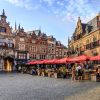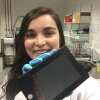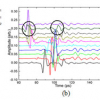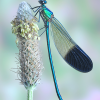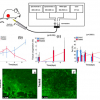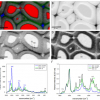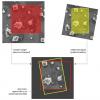Enrico Pigorsch, Matthias Finger, Johanna Kerber and Michael Fleck
PTS Papiertechnische Stiftung, Pirnaer Str. 27, D-01809 Heidenau, Germany
Introduction
Spectral imaging techniques such as infrared reflectography (IRR) or ultraviolet-visible-near infrared (UV-vis-NIR) spectroscopy are well-established tools for examining works of art. In simultaneously providing both spectral and spatial information, these techniques make it possible to reveal invisible features and structures such as underdrawings or changes that have been made in the pictorial composition of paintings.1
Recent advances in sensor technology have extended the available spectral range of NIR imaging systems up to 2200 nm. This makes it possible to add to the existing structural information very specific chemical information and arrive at a chemical imaging analysis in micrometre dimensions.2
NIR chemical imaging measurements offer several advantages and create new possibilities in the analysis of works of art or documents on paper. Measurements conducted with a NIR line camera are totally non-destructive. Frame frequencies of up to 300 Hz allow rapid measurements of large areas. The lateral resolution of the chemical images can be 100 µm or less. In addition, the relatively high penetration depth of the NIR radiation of about 250 µm makes it possible to look not only at the surface but also inside the material or even through to the back of a sheet of paper.
Another interesting property of chemical imaging is the huge quantity of individual spectra recorded in one measurement (e.g. about five million spectra within an area of 30 × 30 cm). This enables the extraction of the chemical information from the spectral data set using unsupervised chemometric methods such as principal component analysis (PCA).3 In this way, chemical structures or individual particles in a material sample can be detected quickly, visualised and eventually identified without much previous knowledge about the sample.
Analytical approach to paper collages
The purpose of this article is to demonstrate the application of NIR chemical imaging measurements to the characterisation and authentication of paper collages. Paper collages or photomontages from the Dada art movement (1916 to 1930s) and from other artists of the 1920s and 1930s are very popular among today’s art collectors, and there exists an active art trade in these works generating high sales values.4 Hence, paper collages are more and more often the subject of forgeries and fraud. In most cases, the forgeries cannot be detected on the basis of scientific art expertise only. Chemical analysis methods must also be employed. Our institute (PTS) has a special expertise in paper analysis and in several cases has already assisted criminologists in revealing forgeries of paper art works. The analytical methods that are predominantly used are IR, NIR and Raman spectroscopy and corresponding spectral imaging techniques.5
In the case of paper collages, NIR imaging measurements can be employed to identify the glue used without have to remove the pieces of paper from the carrier material. Another advantage of the imaging technique is that, for identification purposes, it is sufficient to find among the millions of spectra only a few with a sufficiently high intensity of the characteristic NIR glue bands. These spectra can easily be detected by chemometric methods.
Furthermore, printed text and pictures on the back of the collage paper pieces can be rendered discernible, although they remain invisible when visualised in transmitted light. In most cases, the pieces of paper used in making the collage were taken from contemporary illustrated magazines. In this way, the revealed text phrases or pictures are able to provide hints regarding a specific magazine and the time period or even the exact date of its publication. This in turn allows the given dating of the paper collage to be verified.
Methodology
By way of a demonstration, a small paper collage (15 × 20 cm) was prepared on a thick carton board (300 g m–2) with eight different photo motifs and eight different synthetic and natural glues (Table 1).
Table 1. Collage motifs and the glues used.
No. | Motifs | Glue compounds | Glue products |
1 | Cruiser Ship | Polyvinylpyrrolidone | UHU stic |
2 | Young Man | Cellulose nitrate based | UHU Schnellkleber, hart |
3 | Lanterne | Polyacrylate | UHU Vielzweckkleber |
4 | Model | Polyvinylacetate | Ponal, wasserfest (Henkel) |
5 | Strawberry | Gum arabic | Boesner (Germany) |
6 | Plate | Starch | Potato starch |
7 | Girl | Animal glue (skin) | Zank (Germany) |
8 | Baby | Animal glue (bones) | Zank (Germany) |
The NIR imaging measurements were performed using a self-built measuring system consisting of a NIR camera KUSTA2.2MSI (LLA Instruments GmbH) and a sample table positioned on two movable axes. The NIR camera has a spectral range from 1229 nm to 2157 nm, from which the range between 1300 nm and 1866 nm was used. The InGaAs detector of the camera has 320 spatial pixels and 256 spectral pixels resulting in a spectral resolution of about 4 nm. A frame frequency of 161 Hz was used. The paper collage was scanned with a field of view (width) of 53 mm by moving the y-axis at a speed of 13 mm s–1, resulting in a lateral resolution of about 170 × 80 µm.
The data was analysed using spectral imaging software developed in-house in Matlab (The Mathworks Inc.).
Measurements on the self-designed paper collage
Figure 1 shows the visual image and the grey colour-coded NIR image of the paper collage. The different grey colours of the NIR image represent different grades of reflection of the NIR radiation at a wavelength of 1300 nm. Hence, the picture is not a real chemical image, but it gives an impression of the high lateral resolution of the NIR imaging measurement.

Figure 1. Visual and NIR images of the self-designed paper collage. The grey scale of the NIR image represents absorbance at 1300 nm.
In the strawberry motif of the NIR image, some printed text is already discernible on the back of the piece of paper. The German text is rendered legible by using the fourth principal component of a PCA and changing the orientation of the characters (Figure 2).

Figure 2. Visual and NIR images of strawberry motif. The grey scale of the NIR image represents score values of the fourth principal component.
In order to identify the different glues, it is necessary to find NIR spectra with characteristic NIR bands of the glue that have sufficient intensity. This was done using an unsupervised PCA to examine the NIR imaging data for spectral differences. The PCA was performed for each motif separately. The corresponding images in Figures 3 and 4 show in red colour those points with the highest scores for the principal components that represent the spectral differences due to the glue. In some cases, the PCA loadings already show the characteristic NIR absorptions of the glue compounds. But to achieve a more precise match with the reference spectra for all glues, the average spectra of the respective 10–20 spectra with the highest scores were calculated and finally subtracted with a weighted paper spectrum. The results are shown in Figures 3 and 4. The comparison of the difference spectra with the reference spectra shows very good agreement for all eight glue samples including the natural glues.

Figure 3. NIR images, loadings PC 3 and NIR spectra of the glue for collage motifs 1 to 4. Colour coding represents score values of third principal component. Red spots indicate higher concentrations of the glue substance. The NIR spectra are the reference spectra of the glue (red) and the average spectra of red spots subtracted with a weighted paper spectrum (blue).

Figure 4. NIR images, loadings PC 3 and NIR spectra of the glue for collage motifs 5 to 8. Colour coding represents score values of third principal component. Red spots indicate higher concentrations of the glue substance. The NIR spectra are the reference spectra of the glue (red) and the average spectra of red spots subtracted with a weighted paper spectrum (blue).
Measurements on paper collage art works
Measurements on real paper collage artworks yielded results which are highly illustrative of the information that can be extracted from hidden printed text on the back of the pieces of paper. The paper collages which were investigated belong to a collection of paper collages made by Karl Waldmann.6 The origin of the works and even the real existence of an artist by the name of Karl Waldmann are a continuing subject of debate that will not be discussed here.7 Another unresolved question is the time period during which the paper collages might have been made. The period assumed ranges from 1930 to 1958.
In all examined works, the glue that was found was gum arabic which is not in contrast to the assumed dating of the works. Figures 5 and 6 show two visualisations of hidden prints in two of the paper collages. A printed text and picture were revealed on the back of the brown paper background in the paper collage in Figure 5. Further investigation showed that the brown paper was the cover of an ethnological book entitled “Neu-Guinea”, Schriften-Reihe “Kulturen der Erde”, Folkwang Verlag by Ernst Fuhrmann published in 1922. This was a significant result, because it turned out that photos from this book were used in at least 14 paper collages in the Waldmann collection.

Figure 5. Visual (top) and NIR images (bottom) of the paper collage “Kinder am Strand von Merauke” (No. 902) from the Karl Waldmann collection.6

Figure 6. Visual (top) and NIR images bottom of the paper collage “Ha, ha, ha” (No. 824) from the Karl Waldmann collection.6
The following text in French was found on the back of the red paper strip in the paper collage in Figure 6: “Il doit encore faire … juste reconstruction du … du Temple – magnifique décor de Brasacq et Gabutti-…”. This text can be linked to the famous French film “Les Enfants du Paradis”. The boulevard du Temple in Paris was the major setting of the film, and Léon Brasacq and Raymond Gabutti were the set designers. The film was shot in 1943/44 and first publicly shown on 9 March 1945 in Paris. Therefore, the paper collage could not have been made before 1945.
Conclusions
The investigations showed that NIR imaging measurements are a powerful tool for characterising and authenticating paper collage art works. They can provide decisive clues regarding the material used and the sources of the pictorial motifs which in turn can confirm dates and eventually assist in authenticating works of art.
References
- C. Daffara, E. Pampaloni, L. Pezzati, M. Barucci and R. Fontana, “Scanning multispectral IR reflectographay SMIRR: an advanced tool for art diagnostics”, Acc. Chem. Res. 43, 847–856 (2010). doi: https://doi.org/10.1021/ar900268t
- L. Cséfalvayová, M. Strlic and H. Karjalainen, “Quantitative NIR chemical imaging in heritage science”, Anal. Chem. 83, 5101–5106 (2011). https://doi.org/10.1021/ac200986p
- F.W. Koehler IV, E. Lee, L.H. Kidder and E.N. Lewis, “Near infrared spectroscopy: the practical chemical imaging solution”, Spectrosc. Europe 14(3), 12 (2002). http://bit.ly/2jlIYil
- Gefälschte Dada-Kunst. Der Betrug mit kleinen Werken, Frankfurter Allgemeine Zeitung (15 September 2015).
- E. Pigorsch, M. Finger, St. Thiele and E. Brunner, Application of Raman Microscopy to Analysis of Paper in Documents and Works of Art. 8th International Conference on the Application of Raman Spectroscopy in Art and Archaeology (RAA), Wroclaw (1–5 September 2015).
- www.karlwaldmannmuseum.com (accessed 21 September 2016).
- Thomas Schade, “Der rätselhafte Waldmann”, Sächsische Zeitung (29 August 2015).





